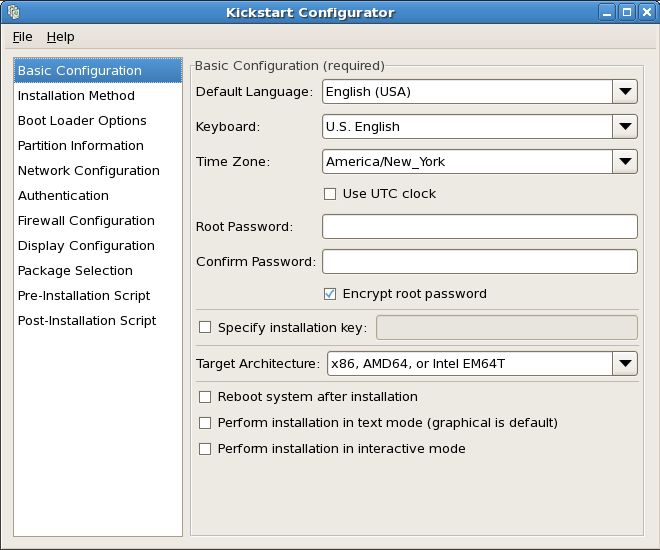Redhat Kickstart File Format

Installing the RedHat Linux OS Using Kickstart This section provides example Kickstart files and the procedures to configure a Kickstart file and then use the Kickstart file to install Linux. Sample Kickstart Files This section provides two example Kickstart files. The first Kickstart file shown in is configured for a full distribution installation of Linux. The second Kickstart file shown in is configured to install only the RPM groups required by the N1 System Manager.
Contents • • • • • • • • • • • • • • • • • • • • • • • • • Many system administrators would prefer to use an automated installation method to install Fedora or Red Hat Enterprise Linux on their machines. To answer this need, Red Hat created the kickstart installation method. Using kickstart, a system administrator can create a single file containing the answers to all the questions that would normally be asked during a typical installation.
Kickstart files can be created in one of three ways: Perform an interactive installation. Once complete you will find the Kickstart configuration file for the installation you just completed in the '/root/anaconda-ks.cfg' file. Automating Linux installations with Kickstart. Red Hat/Fedora offers Kickstart. How to get the best of it and how to use the newly created Kickstart file. Format the Device as a dm-crypt/LUKS Encrypted Device. This section must be placed towards the end of the kickstart file. The following options can be placed in a kickstart file. Tells the installation program not to format the partition, for use with the --onpart command.

Kickstart files can be kept on a server system and read by individual computers during the installation. This installation method can support the use of a single kickstart file to install Fedora or Red Hat Enterprise Linux on multiple machines, making it ideal for network and system administrators. The Fedora installation guide at has a detailed section on kickstart. Wintab Software For Autocad. Kickstart installations can be performed using a local CD-ROM, a local hard drive, or via NFS, FTP, or HTTP. To use kickstart, you must: • Create a kickstart file.
• Create a boot diskette with the kickstart file or make the kickstart file available on the network. • Make the installation tree available. • Start the kickstart installation. This chapter explains these steps in detail. The kickstart file is a simple text file, containing a list of items, each identified by a keyword. Yamaha Xg Ymf740c-v Driver. You can create it by using the Kickstart Configurator application or by writing it from scratch. Driver Autodetected Hpdftex on this page.
The Fedora or Red Hat Enterprise Linux installation program also creates a sample kickstart file based on the options that you selected during installation. It is written to the file /root/anaconda-ks.cfg. You should be able to edit it with any text editor or word processor that can save files as ASCII text.
First, be aware of the following issues when you are creating your kickstart file: • While not strictly required, there is a natural order for sections that should be followed. Items within the sections do not have to be in a specific order unless otherwise noted.